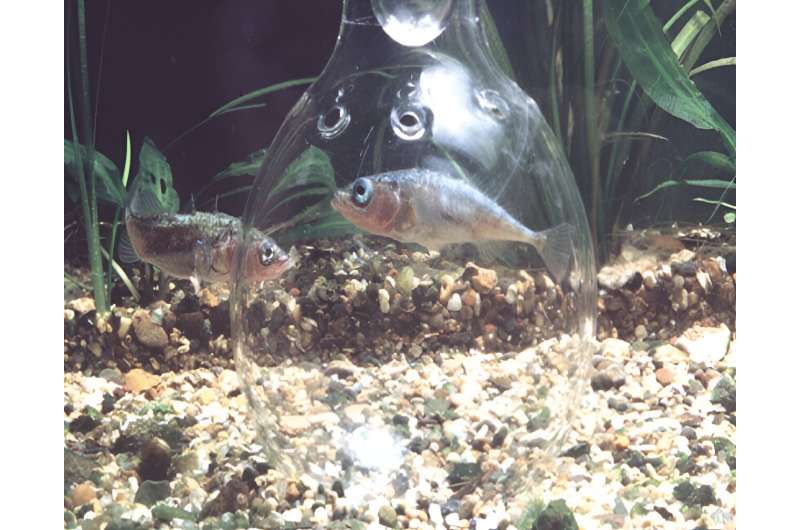This article has been reviewed according to Science X's editorial process and policies. Editors have highlighted the following attributes while ensuring the content's credibility:
fact-checked
peer-reviewed publication
trusted source
proofread
Fish brains may provide insight into the molecular basis of decision-making

How do animals make decisions when faced with competing demands, and how have decision making processes evolved over time? In a recent publication in Biology Letters, Tina Barbasch, a postdoctoral researcher at the Carl R. Woese Institute for Genomic Biology, and Alison Bell (GNDP), a professor in the Department of Ecology, Evolution, and Behavior, explored these questions using three-spined stickleback fish (Gasterosteus aculeatus).
Whether you are in school, working, raising children, managing a social life, or just trying to relax for a moment, managing multiple responsibilities at once can quickly become overwhelming. You may wonder how much simpler life would be if you were a fish floating along a river or a hawk soaring through the sky. Yet, animals also face the burdens of multitasking, whether it be searching for their next meal while avoiding becoming someone else's next meal or attracting a mate while defending their territory.
"During my Ph.D., I studied parental care in clownfish and how they decide how much care to provide for their offspring," says Barbasch. "This requires the integration of many sources of social and environmental information. Recently, I have become interested in understanding the mechanisms underlying how animals make decisions and integrate different sources of information."
Despite the importance of decision-making for an animal's fitness, the mechanisms that shape decision-making are poorly understood.
Sticklebacks are a powerful model for investigating these questions because of their complex life history and reproductive behavior. During the breeding season, male sticklebacks establish territories to build nests to attract females. Males must simultaneously defend their territories from other males, court females that enter their territory with performative swimming motions, called 'zig-zags," and ultimately provide care for offspring if they can successfully court a female.
"This study was inspired by an experiment where we looked at brain gene expression in male three-spined stickleback during parental care or when defending their territory," explained Bell. "We found that the same genes were involved in both experiments, but in opposite directions—genes turned on in one condition were turned off in the other. This idea that the brain might be using the same molecular machinery, but in opposite ways, could have major implications for the evolution of decision making."
To explore the underlying molecular mechanisms of decision-making, Barbasch exposed male stickleback to one of three stimuli: a female stickleback (courtship treatment), another male stickleback (territorial intruder treatment), or both a male and female stickleback (trade-off treatment). Some male sticklebacks were left alone as a control. Aggressive behaviors (biting) and courtship behaviors (zig-zags) were quantified, and then the brains of the male stickleback were dissected to look at gene expression using RNA sequencing.
Barbasch found that, when faced with a trade-off, males generally prioritized territorial defense over courtship. There was also substantial variation across males in how they responded, suggesting that there might be different strategies that males employ when faced with a trade-off. Furthermore, the gene expression results identified groups of genes that were differentially expressed across each experimental treatment relative to a control.
Of particular interest are the genes that are only present in the trade-off treatment because they suggest that males have a unique molecular response when faced with conflicting demands.
"We performed gene ontology analysis on these 'trade-off genes' to look into what the identity and function of these genes might be," describes Barbasch. "Preliminary results suggest the 'trade-off' genes may be related to the dopamine response pathway, which modulates reward and motivation in the brain, or neurogenesis, which is important for cognition."
Ultimately, these findings highlight the importance of exploring the molecular basis of animal behavior, as Bell outlines. "Animals are living really complicated lives across many taxa. This suggests that the mechanisms that are driving complex decision-making are probably really ancient, and animals have been managing complex decisions for a long time."
Barbasch's study also sets the foundation for many exciting follow-up studies. She has already started to explore the behavioral and molecular responses by stickleback to other trade-offs, including those involving predation risk, foraging, and parental care. She also plans on expanding her molecular toolkit by quantifying gene expression in finer detail using single-cell RNA sequencing and weighted gene co-expression network analysis, which helps capture gene function by identifying networks of genes with related patterns of expression.
So, the next time you notice an animal doing something, think a bit deeper about their day-to-day life and how they are finding a way to manage all their responsibilities.
More information: T. A. Barbasch et al, A distinct neurogenomic response to a trade-off between social challenge and opportunity in male sticklebacks (Gasterosteus aculeatus), Biology Letters (2023). DOI: 10.1098/rsbl.2023.0253
Journal information: Biology Letters
Provided by University of Illinois at Urbana-Champaign





















